Amphetamines are a class of compounds increasingly abused in regions of the world such as the western United States, Australasia, and Europe. Synthetic amphetamine compounds commonly are produced in clandestine laboratories and vary in purity and potency. Other potentials for amphetamine abuse include prescription medications and various over-the-counter diet pills.
Clinical effects of amphetamine abuse are significant and commonly observed in EDs. The ED physician's ability to recognize and treat amphetamine intoxication is very important.
The phenylethylamine structure of amphetamine (see the image below) is similar to catecholaminergic, dopaminergic, and serotonergic agonists (biogenic amines), which may explain their actions.
 Amphetamine and epinephrine.
Amphetamine and epinephrine.
The relative activities that amphetamines have to stimulate the receptors of these biogenic amines are dependent on the chemical substituents on the amphetamine molecule; thus, the clinical presentation is dependent on the type of amphetamine used. For example, methamphetamine lacks much of the peripheral stimulant properties of amphetamine while still offering euphoric and hallucinogenic properties. These actions are similar to those of cocaine; however, while effects of cocaine last for 10-20 minutes, duration of amphetamine action is much longer, lasting as long as 10-12 hours.
The routes of amphetamine administration may be oral (ingestion), inhalation (smoke), or injection (intravenous). Oral use is associated with an approximate 1-hour lag time before onset of symptoms, whereas inhaled and intravenous methods yield effects within a few minutes. Peak plasma concentrations occur in 5 minutes with intravenous use, 30 minutes with nasal or intramuscular use, and 2-3 hours postingestion.
Use appears to vary with gender and race. Recent work has found correlations between personality traits (risk taking and reward sensitivity) and responses to amphetamine use
Clinical effects of amphetamine abuse are significant and commonly observed in EDs. The ED physician's ability to recognize and treat amphetamine intoxication is very important.
The phenylethylamine structure of amphetamine (see the image below) is similar to catecholaminergic, dopaminergic, and serotonergic agonists (biogenic amines), which may explain their actions.
 Amphetamine and epinephrine.
Amphetamine and epinephrine.The relative activities that amphetamines have to stimulate the receptors of these biogenic amines are dependent on the chemical substituents on the amphetamine molecule; thus, the clinical presentation is dependent on the type of amphetamine used. For example, methamphetamine lacks much of the peripheral stimulant properties of amphetamine while still offering euphoric and hallucinogenic properties. These actions are similar to those of cocaine; however, while effects of cocaine last for 10-20 minutes, duration of amphetamine action is much longer, lasting as long as 10-12 hours.
The routes of amphetamine administration may be oral (ingestion), inhalation (smoke), or injection (intravenous). Oral use is associated with an approximate 1-hour lag time before onset of symptoms, whereas inhaled and intravenous methods yield effects within a few minutes. Peak plasma concentrations occur in 5 minutes with intravenous use, 30 minutes with nasal or intramuscular use, and 2-3 hours postingestion.
Use appears to vary with gender and race. Recent work has found correlations between personality traits (risk taking and reward sensitivity) and responses to amphetamine use
No comments:
Post a Comment